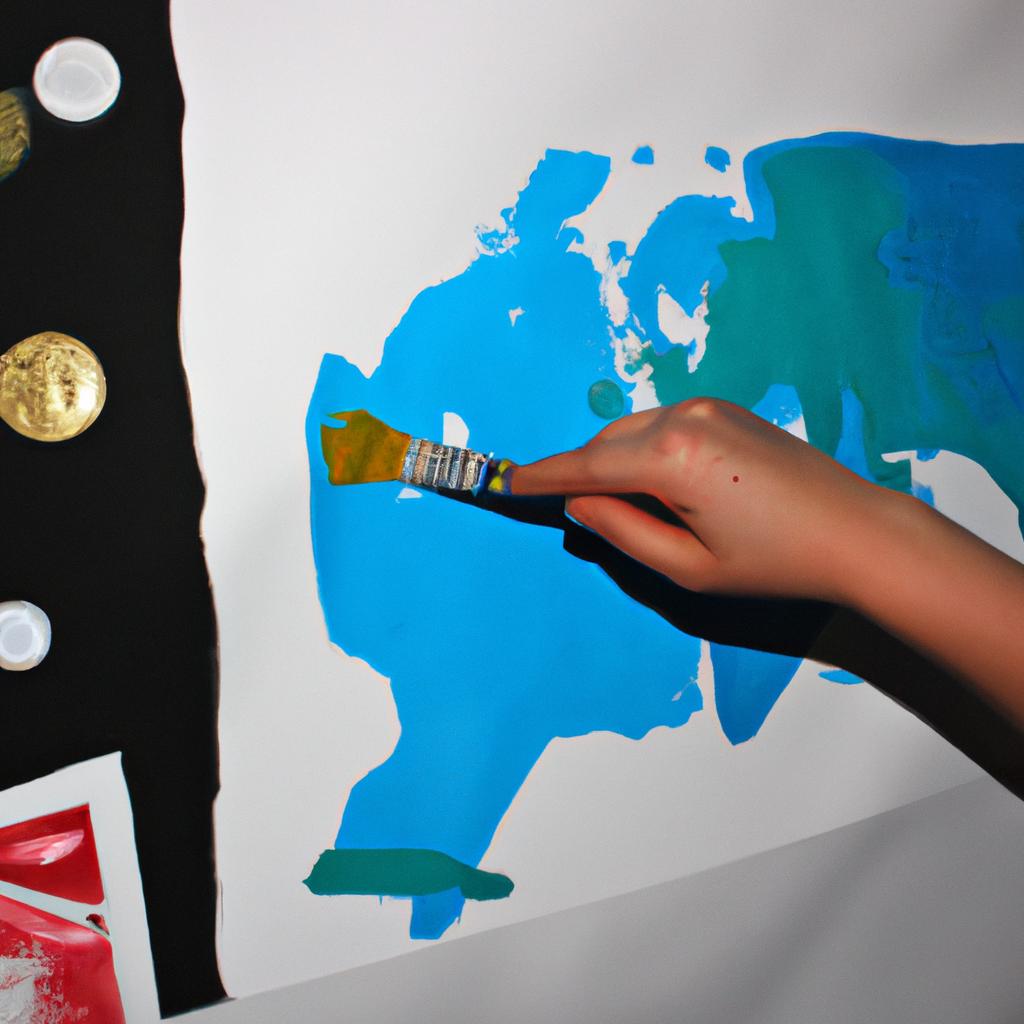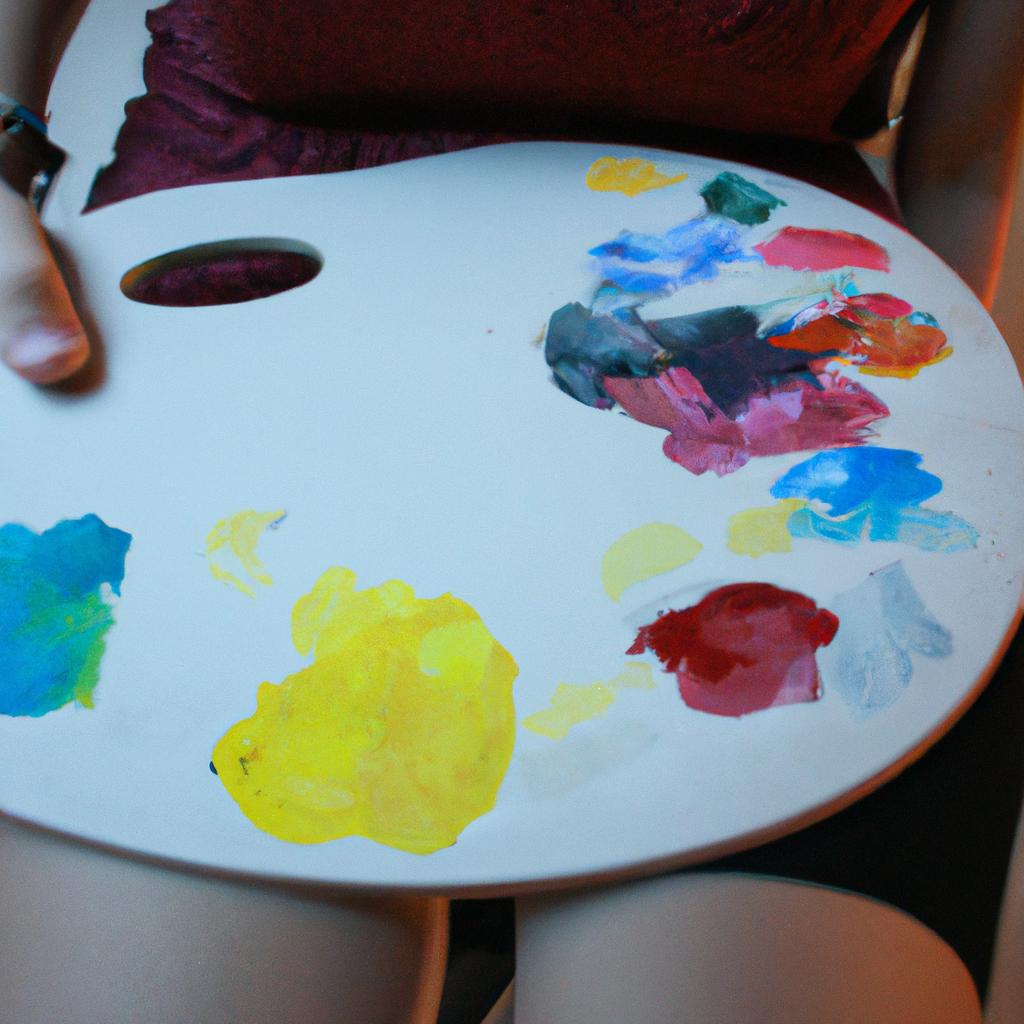Artists and illustrators often find themselves grappling with financial challenges unique to their profession. From managing fluctuating income streams to understanding tax obligations, navigating the world of finance can be overwhelming for creative individuals. However, by employing strategic tax planning techniques tailored specifically for artists, it is possible to optimize one’s finances and ensure sustainable success in this competitive industry.
Consider the case of Emma, a freelance illustrator who recently found herself struggling to make sense of her tax responsibilities. With multiple clients and various types of income sources, she was uncertain about how to accurately report her earnings while maximizing deductions. This scenario highlights the need for artists and illustrators to familiarize themselves with effective finance strategies that can help them navigate the complexities of taxes while minimizing their financial burden.
In this article, we will explore a range of tax tips and creative finance strategies designed specifically for artists and illustrators. By outlining key considerations such as record-keeping best practices, deductible expenses commonly overlooked by creatives, and potential tax credits available within the arts sector, this article aims to provide valuable insights on optimizing financial management in the realm of arts and illustration. Whether you are an established artist or just starting out on your creative journey, these tips will empower you to take control of your finances and achieve financial stability and success in your artistic career.
One of the first steps for artists and illustrators is to establish good record-keeping practices. Keeping track of income, expenses, and receipts is essential for accurately reporting earnings and maximizing deductions. Consider using accounting software or apps specifically designed for freelancers to streamline this process. By maintaining organized financial records, you will have a clear picture of your income and expenses, making it easier to file taxes and identify potential deductions.
Speaking of deductions, it’s important for artists to be aware of the expenses they can deduct on their tax returns. While some common business expenses apply universally across industries (such as office supplies or marketing costs), there are specific deductions that artists can take advantage of. These may include art supplies, studio rent or mortgage interest payments, professional development courses or workshops, travel expenses related to art exhibitions or conferences, website hosting fees, and even a portion of home office expenses if you have a dedicated workspace in your home.
Additionally, artists should explore potential tax credits available within the arts sector. Depending on your location, there may be specific tax incentives or grants aimed at supporting artists and promoting cultural activities. Research local government programs or organizations that offer financial support to artists through grants or subsidies. These opportunities can help offset some of the financial challenges faced by artists and illustrators.
It’s also worth considering whether forming a business entity such as an LLC (Limited Liability Company) makes sense for your artistic practice. While this decision should be made in consultation with a tax professional or accountant who understands the nuances of your specific situation, creating an LLC can provide certain legal protections while offering potential tax benefits. It can also help separate personal finances from business finances, which is especially beneficial for freelancers with fluctuating income streams.
Lastly, don’t underestimate the value of seeking professional advice when it comes to managing your finances as an artist or illustrator. Partnering with a knowledgeable accountant or tax advisor who specializes in working with creatives can provide invaluable guidance tailored to your unique circumstances. They can help you navigate the ever-changing tax laws, maximize deductions, and ensure compliance with all tax obligations.
By implementing these tax tips and creative finance strategies, artists and illustrators like Emma can gain control over their finances and optimize their financial management. With a solid understanding of tax responsibilities, effective record-keeping practices, knowledge of deductible expenses, awareness of potential tax credits, and professional advice when needed, artists can take charge of their financial well-being and focus on what they do best – creating inspiring works of art.
Understanding deductible expenses for artists
To navigate the complex world of taxes as an artist, it is crucial to have a clear understanding of deductible expenses. By identifying what can be deducted from your income, you can significantly reduce your tax liability and maximize your financial resources. Let’s explore some key points to help you better comprehend deductible expenses.
Example: Consider a scenario where Sarah, an illustrator, works from her home studio. She frequently purchases art supplies and materials, attends industry conferences, and occasionally hires models for reference photos. These are all potential deductible expenses that can greatly benefit her financially.
Understanding which expenses qualify for deductions is essential. Here are four common categories of deductible expenses for artists:
- Art Supplies and Materials: This category covers any items directly related to creating artwork, such as paints, brushes, canvas, sketchbooks, or software licenses.
- Professional Development: Attending workshops, seminars, or conferences relevant to your artistic field is considered a deductible expense.
- Marketing and Promotion: Costs associated with promoting your work—such as website maintenance fees or printing promotional materials—are generally eligible for deduction.
- Studio Space: If you utilize a dedicated space in your home exclusively for artistic purposes, you may be able to deduct a portion of rent or mortgage payments relating to that area.
| Category | Description |
|---|---|
| Art Supplies and Materials | Items purchased directly involved in the creation of artwork |
| Professional Development | Workshops, seminars, conferences related to improving skills or expanding knowledge |
| Marketing and Promotion | Costs incurred while advertising and promoting one’s art |
| Studio Space | Rent or mortgage payments applicable to an exclusive area used solely for artistic endeavors within one’s residence |
By utilizing these tips on understanding deductible expenses as an artist, you can optimize your tax benefits and potentially increase your financial resources. In the subsequent section, we will delve into strategies for maximizing deductions specifically related to art supplies and materials.
Now that you have a grasp of deductible expenses, let’s explore how you can maximize deductions for art supplies and materials.
Maximizing deductions for art supplies and materials
Understanding deductible expenses for artists is crucial when it comes to optimizing your tax savings. By identifying and categorizing eligible expenses, you can minimize the amount of taxable income attributed to your artistic practice. Let’s explore some key considerations in this regard.
For instance, let’s say you are an illustrator who primarily works from home. In order to create your artwork, you often purchase specialized software and digital drawing tools. These expenses can be deducted as business expenses under “art supplies” or “materials.” However, keep in mind that personal use items, such as a computer used for both work and leisure activities, may only qualify for partial deductions based on their percentage of business use.
To help ensure you’re accurately accounting for deductible expenses and maximizing your tax savings as an artist, consider the following:
- Keep detailed records: Maintain a comprehensive record of all purchases related to your artistic endeavors, including receipts and invoices. This will make it easier to identify deductible expenses during tax season.
- Consult with a tax professional: Tax laws can be complex and subject to change. Seeking guidance from a qualified tax professional specializing in arts-related deductions can help ensure you’re taking full advantage of available benefits.
- Understand applicable regulations: Familiarize yourself with relevant tax regulations specific to artists’ deductibles in your jurisdiction. Different countries or regions may have different rules regarding what qualifies as deductible expenses.
- Separate personal and business finances: To simplify expense tracking and demonstrate the legitimacy of your claims, maintain separate bank accounts and credit cards specifically designated for your art-related transactions.
Consider the following hypothetical table showcasing potential deductible expenses commonly incurred by artists:
| Expense Category | Examples |
|---|---|
| Art Supplies | Paints, brushes, canvas |
| Studio Rent | Monthly lease payments |
| Education | Workshops & classes |
| Marketing | Website design costs, advertising |
By understanding deductible expenses and implementing proper record-keeping practices, you can optimize your tax savings as an artist.
Taking advantage of home office deductions for artists allows you to claim a portion of your household expenses related to your workspace. Stay tuned to discover how this deduction can benefit your artistic endeavors and help alleviate some of the financial burdens associated with pursuing your passion.
Taking advantage of home office deductions for artists
Building upon the previous strategies, artists can further optimize their tax deductions by exploring the benefits of home office expenses. Let’s delve into this topic to understand how artists can take advantage of these deductions.
To illustrate the potential savings, let’s consider an example. Emily is a freelance illustrator who works from her home studio. She designates a dedicated area in her house solely for her artistic endeavors. By utilizing this space exclusively for business purposes, Emily becomes eligible to claim home office deductions on her taxes.
There are several key points that artists should keep in mind when it comes to maximizing their home office deductions:
- Space allocation: Determine the percentage of your living or working space that is used as a home office. This calculation will be crucial while claiming expenses related to rent, mortgage interest, utilities, insurance, and property taxes.
- Direct vs indirect expenses: Differentiate between direct and indirect expenses associated with your home office. While direct expenses pertain specifically to the designated workspace (e.g., painting supplies), indirect expenses cover costs related to maintaining your entire residence (e.g., electricity bills).
- Simplified option: Consider using the simplified method provided by the IRS if you prefer not to itemize each individual expense. Under this method, you calculate your deduction based on $5 per square foot of your home office space, up to 300 square feet.
- Documentation: Maintain thorough documentation of all relevant receipts and invoices pertaining to your home office expenses. These records will serve as evidence during an audit and help substantiate any claims made on your tax return.
By leveraging these strategies effectively, artists like Emily can significantly reduce their taxable income and increase their overall savings come tax season.
Now let’s explore another critical aspect of managing finances as an artist – keeping thorough records of income and expenses – which plays a vital role in ensuring accurate reporting and minimizing financial discrepancies.
Keeping thorough records of income and expenses
Taking advantage of home office deductions can be a significant benefit for artists. By designating an area in your home exclusively for work purposes, you may qualify for tax deductions that can help reduce your overall taxable income. Let’s consider an example to illustrate this strategy:
Case Study: Sarah is a freelance illustrator who works from home. She has set up a dedicated room as her art studio and uses it solely for her artistic endeavors. As part of her annual tax preparation, she calculates the square footage of her studio compared to the total square footage of her house. This ratio allows Sarah to determine what percentage of certain household expenses, such as rent or mortgage interest, utilities, and insurance, she can deduct as business expenses.
To fully maximize the benefits of home office deductions, here are some key considerations:
- Keep detailed records: Maintain thorough documentation of all expenses related to your home office. This includes invoices, receipts, bills, and any other relevant paperwork.
- Consult with a tax professional: Tax laws regarding home office deductions can be complex and subject to change. Seeking guidance from a qualified tax professional will ensure you’re taking full advantage of available opportunities while staying compliant with regulations.
- Understand the limitations: Home office deductions typically cannot exceed your net income from self-employment. Additionally, if you use your home office for personal activities outside work hours (such as watching TV or using it as a guest bedroom), those areas would not qualify for deduction.
By utilizing these strategies effectively and keeping accurate records, artists like Sarah can potentially enjoy substantial savings on their taxes through home office deductions.
Now let’s delve into another crucial aspect of managing finances as an artist – keeping thorough records of income and expenses.
| Key Considerations |
|---|
| Maintain accurate records |
| Separate personal and business transactions |
| Save receipts |
| Use accounting software or apps |
Keeping thorough records not only ensures compliance with tax regulations but also provides you with valuable insights into your artistic career’s financial health. By having a clear picture of your income sources and expenses, you can make informed decisions to optimize your finances.
Transitioning into the subsequent section about “Utilizing tax credits and deductions for art-related education,” it is essential to explore additional ways artists can leverage the tax system to support their ongoing growth as creative professionals.
Utilizing tax credits and deductions for art-related education
Building on the importance of maintaining thorough records, let us now explore how artists can take advantage of tax credits and deductions related to art-related education.
Artists often engage in continuous learning and skill development through workshops, courses, or even pursuing higher degrees in arts and illustration. These educational pursuits not only enhance their creative abilities but also offer potential financial benefits when it comes to taxes. For instance, imagine a freelance illustrator named Sarah who decides to enroll in a specialized course on digital painting techniques. By understanding the tax implications associated with such investments in her artistic career, Sarah can make informed decisions that may positively impact her bottom line.
To maximize the potential tax benefits from art-related education expenses, consider the following strategies:
- Deductible Expenses: Many costs associated with education can be claimed as deductions if they are directly connected to improving your skills as an artist. This includes tuition fees for courses or workshops focused specifically on enhancing artistic abilities.
- Supplies and Materials: Artistic materials required for educational purposes, such as paints, brushes, sketchbooks, software subscriptions, or even reference books specific to your field of study, may be deductible.
- Travel Expenses: If attending an educational event requires traveling away from home (e.g., a conference), certain travel expenses like airfare or accommodation might qualify for deduction.
- Networking Opportunities: Some networking events or professional conferences organized by industry associations present valuable opportunities for artists to learn and grow within their field. The registration fees for these events could potentially be deducted as well.
Consider this hypothetical example illustrating how these strategies can work together:
| Expense Type | Amount ($) |
|---|---|
| Digital Painting Course | 1,000 |
| Art Supplies | 500 |
| Airfare | 300 |
| Conference Registration | 200 |
By leveraging available deductions and credits tied to her investment in art-related education ($2,000 in this case), Sarah can reduce her taxable income. This ultimately leads to potential savings on her tax bill.
As artists navigate the complexities of their taxes, it is essential to understand how education-related expenses can benefit them financially. By keeping thorough records and diligently tracking relevant costs, individuals like Sarah can optimize their tax returns while simultaneously expanding their artistic horizons.
Now let us delve into the intricacies of navigating the tax implications associated with selling artwork without overlooking any important considerations.
Navigating the tax implications of selling artwork
Utilizing tax credits and deductions for art-related education can greatly benefit artists and illustrators seeking to further develop their skills and knowledge. By understanding the available opportunities, individuals in the creative field can make informed decisions that not only enhance their artistic abilities but also provide financial advantages.
For instance, consider an artist named Sarah who wants to improve her painting techniques by enrolling in a specialized workshop. In this hypothetical case study, Sarah pays $1,500 for the workshop fee and incurs additional expenses of $300 for art supplies. Through careful planning and research, she discovers several tax benefits related to her art-related education:
- Lifetime Learning Credit: Artists like Sarah may be eligible for a Lifetime Learning Credit, which helps offset educational expenses. This credit allows taxpayers to claim up to 20% of qualified tuition fees paid, with a maximum limit of $2,000 per year.
- Business Expense Deduction: If Sarah is already established as a professional artist or illustrator and attends the workshop to maintain or improve her existing skills, she may be able to deduct the cost of these educational activities as business expenses on her tax return.
- Scholarships or Grants: Artists should explore funding options such as scholarships or grants specifically designed for arts education. These awards can help cover some or all of the costs associated with workshops, courses, or other forms of artistic training.
- Artist Residency Programs: Some artists pursue residency programs that offer unique learning experiences while providing potential tax benefits. While specific regulations vary depending on location and program details, participating in certain residencies might qualify individuals for certain deductions or credits.
Table: Tax Benefits for Art-Related Education
| Type | Description |
|---|---|
| Lifetime Learning Credit | Offset educational expenses up to $2,000/year |
| Business Expense Deduction | Deduct qualifying educational costs from taxes |
| Scholarships/Grants | Seek financial assistance for art education |
| Artist Residency Programs | Explore unique opportunities with tax benefits |
Taking advantage of these tax credits and deductions can alleviate the financial burden associated with pursuing art-related education. However, it is essential to consult a qualified tax professional or accountant who specializes in working with artists and illustrators. They can provide personalized advice based on individual circumstances, ensuring compliance with relevant laws and regulations.
By understanding the available options, artists like Sarah can not only expand their artistic horizons but also optimize their finances through strategic planning and leveraging various tax incentives. Embracing lifelong learning becomes more accessible when coupled with smart financial decision-making that supports both personal growth and fiscal responsibilities.
 PSP Oste
PSP Oste



